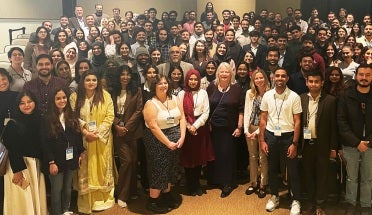
Global Virtual Exchange Fosters Intercultural Connections for Students and Faculty
- Mar 24, 2022
- Global Programs and Innovation
- by Sophia Aitken
Texas Global has awarded funding for several new courses to be added to the exciting roster of Global Virtual Exchange (GVE). The new courses will be co-taught with institutions from Brazil, Mexico, England and South Korea.
Under the GVE initiative, faculty from The University of Texas at Austin are invited each year to apply for a grant to develop and implement a virtual exchange between students with a partner institution abroad. For those UT Austin faculty members who receive GVE funding, the opportunity for international collaboration meets longtime university goals of deepening bonds abroad and facilitating cross-cultural exchange for students.
Thus far, 62 grants have been awarded for exchanges among 36 countries. Through Fall 2021, GVE courses have served 3,310 students, 1,609 of whom are from UT Austin, and 1,701 who are international.
Connecting Globally via Social Media
Alida Louisa Perrine, Ph.D., one of this year’s GVE grant recipients, will be co-teaching “Black Digital Feminisms in Brazil” with Dr. Carla Ramos Munzanzu from Universidade Federal do Oeste do Pará (UFOPA) in Brazil. The two scholars met at UT Austin while enrolled in their respective doctorate programs.
“Co-teaching a course with my dear friend Carla is going to be a wonderful personal achievement for both of us because it’s a new way for us to collaborate, and something that we’ve talked about literally for years,” said Dr. Perrine.
For her, the grant from GVE allows her to teach the “course of her dreams” as part of her long-term career goal of connecting U.S. and Brazilian conversations about Black feminism.
“There are so many parallels, and there's so much richness of thought in both places. I think that people who care about issues related to race and gender in the United States will benefit so much from learning about the way those topics are being approached in Brazil,” said Dr. Perrine.
UT and UFOPA students in this course will form mixed groups and create their own social media accounts for several platforms to produce bilingual content that reflects course readings and discussions on the major tenets of Black feminism in Brazil. The Portuguese-English language barrier plays an integral part in the course design, said Dr. Perrine, as students from both countries confront the common intercultural phenomenon of interacting with people who don't speak their own language fluently, yet still managing to connect over important issues.
“In Brazil, social media is a huge way that Black women are finding a platform to speak out against racism and sexism and connect with each other,” said Dr. Perrine. “I think the students will be impressed to see that this topic that is so important here in the United States is relevant in other places, too.”
Dr. Perrine and Dr. Ramos are also looking forward to dialoguing with the Brazilian students on cross-cultural comparisons of race, racism and social media that resonate in both contexts. “I really do think it will be a valuable exchange both ways,” said Dr. Perrine.
Co-Producing Content
Similarly, professor Octavio Kano-Galván chose to center his GVE course curriculum on social media content creation in the interest of yielding fruitful cross-cultural exchange. His initial course, “Digital Social Media Production,” was offered in Spring 2021 and co-taught with the Universidad Iberoamericana in Mexico City.
“This course gave us the opportunity to consider differences and similarities between our respective countries about how we convey information through social media,” said Kano-Galván. “There were a lot of cultural components that really enriched the students’ projects.”
Students worked in groups to produce videos for TikTok and YouTube on topics ranging from COVID vaccination to the representations of Mexican food in Mexico and around the world. Students from the U.S., Mexico and China were enrolled, and their cultural differences led to a diversity of perspectives and approaches. Maritza Gutierrez, a UT Austin student in the course, found that those differences enhanced the work produced.
“It was great to see how their editing and filming styles were different to those of our own here in America, as well as the topics,” said Gutierrez. “The students [from Mexico] are very talented, and it was an honor to experience their work.”
The group dynamic also led Gutierrez to reconnect with her heritage, thanks in part to her Mexican teammate Alejandro Paredes-Huerta. “Although I come from a Mexican-American background, I know I didn't grow up deeply immersed into the culture, so having Alejandro there was like a breath of fresh air,” she said.
Her professor concurred, having experienced a similar situation. “It’s like returning to Mexico, in a way,” Kano-Galván said. After studying and working in the advertising industry as an art director in the U.S., he had wanted to return to his native Mexico but did not have the opportunity to do so. Decades later, GVE gave him the occasion to facilitate an interchange for his students, and in a way, to take advantage of his own return to his roots.
With a continuing mission to create bonds between students from different countries, Kano-Galván was awarded a second GVE grant to teach “360 Video Production.” For this course, students will work in teams across institutions to create content for virtual reality experiences, with the goal of developing a comprehensive advertising campaign for their final project.
The new course will be co-taught with faculty from two institutions: professor Alfonso Diaz Villaseñor from Universidad Anahuac in Mexico and professor Zakera Kali Haq from De Montfort University in the United Kingdom. Similar to UT Austin, De Montfort’s student body is diverse, representing many countries from around the world, which Kano-Galván believes will make for an exceptionally dynamic semester together.
Another beneficial aspect of GVE’s virtual model is that it can provide an accessible platform for a greater number of participants than traditional study abroad. Bypassing potential economic constraints, faculty and students can easily participate in the virtual model to gain global perspectives and create international networks.
“I think it’s such a great opportunity for everyone to learn and make contact with peers around the world,” said Kano-Galván. "Travel abroad changes your perspective, and it's super important that every single student have the opportunity to experience that. If you aren't in a position to go abroad, this experience will inspire you to seek opportunities to do so.”
Kano-Galván looks forward to watching the students grow, expanding their horizons with yet another cultural exchange during his next course. He’s curious about what he will learn from the students this time, especially as it relates to perceptions of the U.S. abroad. “You always learn from students. That's what makes teaching so fulfilling,” he said.
Sharing Culture in Conversation
Professor Alice McCoy-Bae’s GVE course, “Third-Year Korean I” is a content-enhanced intermediate language course with a corresponding focus on intercultural exchange, taught in collaboration with a university partner in South Korea.
The South Korean students will enroll in an English-language and American culture course. They will work collaboratively with professor McCoy-Bae’s students so that both groups can enhance their understanding of each other’s culture.
“We use a textbook to teach this course, [but] with the exchange, their understanding is not limited to the textbook knowledge. It goes beyond what’s written in the textbook by interacting with students from the authentic culture and expanding their worldview,” said McCoy-Bae.
She believes that the process of comparing and contrasting each other’s societies will give UT students the space to reflect on their own heritage, as well. “That’s how we get to understand not only the target culture, but also our own culture,” she continued. “Sometimes, we are so blinded because we live here that we don’t really think about what we do here.”
The idea for this GVE course has long been circulating in McCoy-Bae's mind. Her Korean-language students have been contributing since 2019 to a blog project in which they research and discuss their questions about Korean society. But until recently, they did not have the opportunity to dialogue directly with Korean students.
Last semester, McCoy-Bae and another South Korean partner piloted an intercultural communications project for students of both institutions, using a Facebook group to engage in an ongoing exchange. This GVE course will pose the first opportunity to deepen such an exchange, allowing students to meet synchronously to converse and collaborate on class projects.
Kano-Galván echoed the sentiment of connection and inclusion, emphasizing the value of the nations and institutions involved in his Global Virtual Exchange course. He highlighted GVE’s importance for not only his students but also his teaching, stating simply, “I owe so much to both countries; I need to participate in these exchanges.”
For more information on faculty and student opportunities offered by this program, visit the Global Virtual Exchange Initiative page of the Texas Global website.



